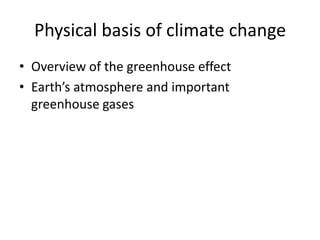
Physical basis of climate change: The greenhouse effect
- 1. Physical basis of climate change • Overview of the greenhouse effect • Earth’s atmosphere and important greenhouse gases
- 2. Earth’s atmosphere H2O SO2 Ar CO2 N2 78% 0% 0% 1% 0% O2 O2 21% 21% Ar 0.93% CH4 0.015% CO2 0.0395% N2 N2O 0.0000% 78% Pressure 1 bar
- 3. Is Earth like its ‘twin’ planet, Venus? • Earth and Venus are similar in size, density, gravity, length of year, internal structure, total carbon content.
- 4. Earth’s vs. Venus’ atmosphere H2O Ar CO2 SO2 0% 1% 0% 0% Earth Earth Venus O2 21% N2 78% 3.5% O2 21% 0.000% N2 78% Ar 0.93% 0.007% CO2 0.0395% 96.5% H2O N2 Pressure 1 bar 92 bars Venus 4%0% CO2 96%
- 5. So what? In 1896 Svante Arrhenius proposed that CO2 emissions from the use of coal would cause global warming
- 7. Source: Global Warming Art Project
- 8. Greenhouse effect Earth Venus Average temperature 15˚ C 467˚ C Temperature without greenhouse effect -18˚ C -42˚ C Greenhouse effect 33˚ C 509˚ C
- 9. Source: Stabilization Targets (NRC Report)
- 10. Temperature change movie For context: 5-6 deg C = difference between now and last glacial maximum
Editor's Notes
- surface of Venus is 92 times the pressure on Earth. This thick carbon dioxide atmosphere traps heat from the Sun, and has caused temperatures on the planet to soar to 735 Kelvin (461 degrees Celsius). This makes Venus the hottest planet in the Solar System – even hotter than Mercury. Scientists think that Venus might have look similar to Earth in the distant past, with liquid water on the surface, but it’s all gone now.
- Venus succumbed early to a "runaway water vapor greenhouse," in which the increased water vapor content arising from increased temperature reached an end state with much of the ocean evaporated into the atmosphere. Once this happens, it is easy for the water vapor to decompose in the upper atmosphere, whereafter the light hydrogen escapes and oxygen either escapes or reacts with rocks. One hypothesis is that the weak magnetic field at Venus, which otherwise would protect the planet from the solar wind, is one reason for why the oxygen and hydrogen escaped faster into space. Once water is lost, the reaction that turns carbon dioxide into limestone can no longer take place, so CO2 outgassing from volcanoes accumulates in the atmosphere instead of staying bound up in the rocks. The end state of this process is the current atmosphere of Venus, with essentially no water in the atmosphere and essentially the planet’s whole inventory of carbon in the form of atmospheric CO2. Earth, in contrast, kept its water, which allowed the planet to keep most of its carbon inventory safely bound up in the crust. The amount of CO2 in the atmosphere of Venus is approximately the same as the amount of CO2 bound up in the form of carbonate rocks on Earth today. For an atmosphere saturated with water vapor, but with no CO2 in it, the threshold absorbed solar radiation for triggering a runaway greenhouse is about 350 Watts/m2 (see KastingIcarus74 (1988)). The addition of up to 8 times present CO2 might bring this threshold down to around 325 Watts/m2 , but the fact that the Earth’s atmosphere is substantially undersaturated with respect to water vapor probably brings the threshold back up to the neighborhood of 375 Watts/m2. Allowing for a 20% albedo (considerably less than the actual albedo of Earth), our present absorbed solar radiation is only about 275 Watts/m2, comfortably below the threshold. The Earth may well succumb to a runaway greenhouse as the Sun continues to brighten over the next billion years or so, but the amount of CO2 we could add to the atmosphere by burning all available fossil fuel reserves would not move us significantly closer to the runaway greenhouse threshold. There are plenty of nightmares lurking in anthropogenic global warming, but the runaway greenhouse is not among them. RealClimate.org - http://www.realclimate.org/index.php/archives/2006/04/lessons-from-venus/
- http://earthguide.ucsd.edu/earthguide/diagrams/greenhouse/index.html